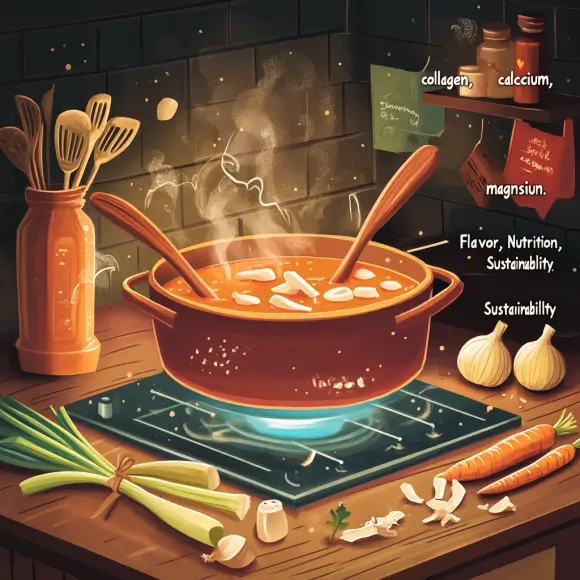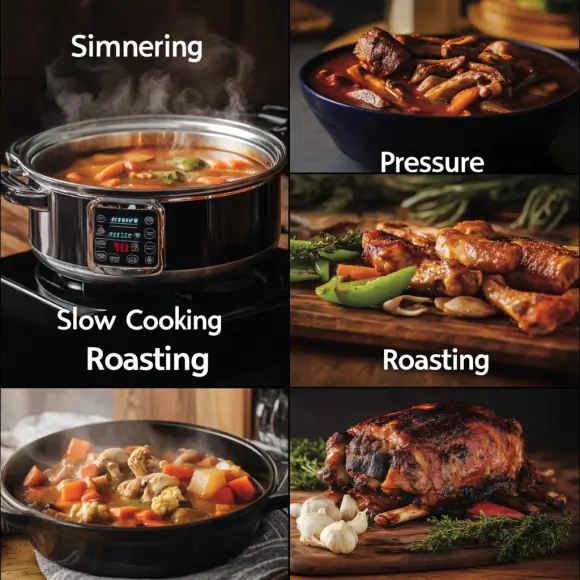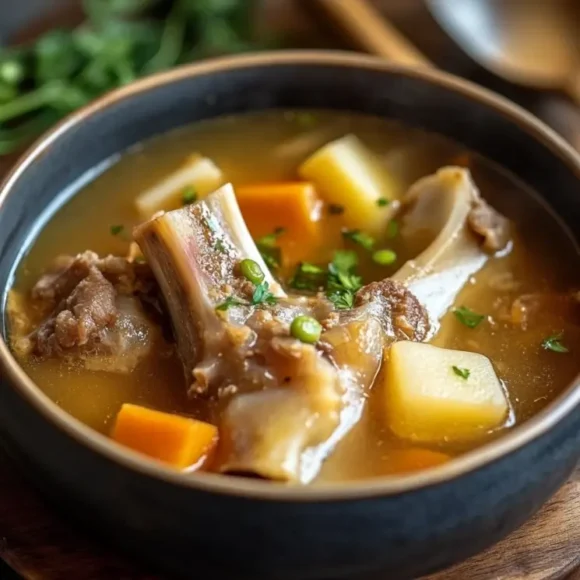Understanding Soup Bone
Soup bones are a vital ingredient in many culinary traditions worldwide. They typically come from the leftover bones of beef, chicken, pork, or lamb and are rich in nutrients. Often overlooked, these bones hold the key to creating flavorful stocks, broths, and soups that Enrich the depth of any dish.
Understanding soup involves recognizing their unique role in infusing natural flavors. When simmered, they release gelatin, marrow, and minerals that add richness to your recipes. Whether you’re an amateur cook or a seasoned chef, soup bones are an essential component of creating nourishing and delicious meals.
In this article, we’ll discover the significance of soup, their preparation methods, and their various uses. By the end, you’ll be equipped with the knowledge to maximize this underrated ingredient in your kitchen.
The Importance of Soup Bone in Cooking
The Soup is far more than a kitchen by product; they serve as the foundation for many dishes. Here’s why they matter:

Flavor improvement: Simmering soup bones creates a robust, umami-rich flavor base for soups, stews, and sauces.
Nutritional Value: They are packed with collagen, calcium, and magnesium, which support bone and joint health.
Sustainability: Using soup bones reduces food waste by utilizing parts of the animal often discarded.
Additionally, the soup provide a cost-effective way to improve your cooking. For those seeking wholesome, nutrient-rich meals, soup bones are indispensable. Whether you’re making a simple chicken broth or a complex French consommé, their inclusion Guarantees a depth of flavor that cannot be achieved with store-bought alternatives.
For instance, if you enjoy experimenting with unique recipes, you might appreciate learning about other creative culinary ideas, such as this ultimate broccoli zucchini recipe, which pairs well with a robust soup base.
Types of Soup Bones
Not all soup bones are created equal, and their type significantly affects the final dish. Common categories include:
1. Beef Soup Bones
- Examples: Knuckle bones, shank bones, marrow bones.
- Best for: Rich broths and hearty soups due to their high gelatin content.
2. Chicken Soup Bones
- Examples: Carcasses, wings, and necks.
- Best for: Light, clear soups like chicken broth or Asian-inspired dishes.
3. Pork Soup Bones
- Examples: Ham hocks, neck bones.
- Best for: Smoky, flavorful soups and stews.
4. Lamb Soup Bones
- Examples: Shanks, neck bones.
- Best for: Mediterranean and Middle Eastern soups.
Each type of soup bone brings its unique flavor profile and nutritional benefits. When choosing soup bones, consider the dish you’re preparing to Guarantee the best match.
Pairing the right bone with complementary ingredients can make a difference. Try crafting sides like this perfect ditalini recipe guide to accompany your soup and round out your meal.
How to Prepare Soup
Proper preparation is crucial to fully realize the potential of the soup. Follow these steps to get started:
- Select Fresh Bones: Choose meaty bones with visible marrow and a minimal amount of fat. Freshness Guarantees better flavor and nutrient retention.
- Rinse Thoroughly: Rinse the bones under cold water to remove impurities and blood that could cloud the broth.
- Roast for Flavor (Optional):
- Spread the bones on a baking sheet.
- Roast at 400°F for 30-45 minutes.
- Roasting improves the flavor and caramelizes natural sugars.
- Blanch (Optional): For a clearer broth, blanch the bones in boiling water for a few minutes, then drain and rinse.
- Combine with Aromatics: Add onions, carrots, celery, and herbs for a balanced base.
Proper preparation Assures the soup is ready to deliver maximum flavor and nutrients.
If you’re looking for a unique twist, consider incorporating soup bones into a base for inventive dishes, like these mini lasagna noodles that pair wonderfully with rich broths.
Cooking Methods for Soup Bone

Different cooking techniques allow you to extract various flavors and nutrients from the soup, and each method offers unique benefits. By exploring these options, you can tailor your approach to fit your schedule and culinary goals. Let’s take a closer look at the most effective ways to prepare soup bones.
1. Simmering
To begin with, simmering is one of the most traditional methods. By cooking the bones on low heat for 6-12 hours, you can slowly extract rich flavors and nutrients. This method is particularly effective for creating a nutrient-dense stock that serves as the perfect base for soups, stews, and sauces. Furthermore, the slow cooking process allows the natural gelatin in the bones to release gradually, resulting in a thick and luxurious broth.
2. Pressure Cooking
On the other hand, if you’re short on time but still want excellent results, pressure cooking is an excellent choice. Unlike simmering, this method significantly reduces cooking time to just 1-2 hours. Despite the shorter cooking period, pressure cooking effectively draws out the flavors and nutrients from the soup. Because of its efficiency, it’s ideal for busy cooks looking to prepare a flavorful broth without spending all day in the kitchen.
3. Slow Cooking
For those who prefer a hands-off approach, slow cooking is another fantastic option. This method gently cooks soup bones for 8-24 hours, making it perfect for extracting a high level of gelatin and collagen. Additionally, the extended cooking time secures the broth is packed with depth and complexity. By setting up a slow cooker, you can leave it unattended, making this method convenient for those with busy lifestyles.
4. Roasting
Before simmering or slow cooking, consider roasting the soup. Roasting not only adds depth to the broth but also introduces smoky and caramelized undertones. For example, by roasting the bones in the oven at a high temperature for 30-45 minutes, you can bring out a unique richness that improves the overall flavor of your stock.
Key Tips for All Methods
- Regardless of which method you choose, always use a combination of soup bones and aromatics like onions, carrots, celery, and herbs to create a well-balanced base.
- Also, remember to skim the surface of the broth occasionally to remove impurities. This step guarantees a clear and clean final product.
By experimenting with these methods, you can discover which one works best for your needs. Whether you prefer the traditional approach of simmering or the quick efficiency of pressure cooking, each technique brings out unique qualities that make soup bones an essential ingredient in your kitchen.
4othe perfect approach for your favorite recipes.
Health Benefits
Soup bones are not just flavorful—they’re also incredibly nutritious. Here are some health benefits:
- Rich in Collagen: Supports joint health, improves skin elasticity, and strengthens hair and nails.
- High in Minerals: Provides calcium, magnesium, and phosphorus, essential for strong bones.
- Gut Health Booster: Contains gelatin, which aids digestion and promotes a healthy gut lining.
- Immune Support: Bone broth made from the soup is a traditional remedy for colds due to its anti-inflammatory properties.
Consuming soup bones regularly can be a simple way to Enrich your overall well-being while enjoying delicious meals.
Storing and Using Soup Bone
Proper storage Assures the soup remain fresh and flavorful:
- Refrigeration:
- Store fresh soup bones in an airtight container for up to 3 days.
- Use them promptly to avoid spoilage.
- Freezing:
- Wrap bones in plastic wrap or freezer-safe bags.
- Store for up to 6 months in the freezer.
- Thaw in the refrigerator overnight before use.
Tips for Efficient Use:
- Portion bones based on your recipe needs before freezing.
- Label each bag with the type of bone and date of freezing.
Storing the soup correctly Assures you always have this versatile ingredient on hand.
Creative Ways to Use Soup Bone
Soup bones are incredibly versatile, and with so many ways to use them, you’ll never run out of ideas to improve your cooking. For example, one of the most common and effective uses is to make a classic stock, which serves as the foundation for soups, risottos, or gravies. Not only does it add richness, but it also infuses your dishes with a depth of flavor that’s hard to achieve with store-bought options.
Moreover, you can create a bone broth by simmering soup bones with herbs and spices. This method results in a nutrient-packed drink that is both comforting and health-boosting. Similarly, the broth can also be used in sauces and gravies, where it provides complex and rich flavors that improve even the simplest meals.
Another fantastic use is turning soup bones into dog treats. After cooking, some soup bones, when prepared safely, can become a delightful snack for pets. However, Assure they’re raw or thoroughly supervised to avoid splintering.
In addition to these options, you can Enrich grains like rice, quinoa, or barley by cooking them in bone broth instead of water. This small change makes a significant difference, infusing the grains with subtle, savory notes. Finally, roasted soup bones can be added to vegetable soups to create a hearty, flavorful twist that turns a simple dish into something extraordinary.u can improve your cooking to new heights while enjoying their many health benefits. Experiment with different types and methods to discover your unique preferences and make the most of this invaluable ingredient.
Common Mistakes to Avoid
When working with the soup, it’s easy to make errors that can affect the flavor, texture, or nutritional value of your final dish. Avoid these common mistakes to Assure success:
1. Skipping Roasting
- Roasting soup bones before simmering brings out rich, caramelized flavors that improve your broth. Failing to do so can result in a flat or bland stock.
2. Not Skimming Impurities
- Soup bones release scum and impurities during the initial boiling phase. Skipping this step can lead to a cloudy broth with an undesirable taste.
3. Using the Wrong Bones
- Not all soup bones are ideal for every recipe. Marrow bones are great for richness, while knuckle bones offer higher gelatin content.
4. Overcooking Aromatics
- Adding vegetables too early can result in overcooked, mushy vegetables that overpower the broth. Add them during the last couple of hours.
5. Ignoring Proper Storage
- Improperly stored soup bones can spoil quickly, resulting in wasted ingredients and time.
Avoiding these pitfalls will improve the quality of your soups and broths.
Frequently Asked Questions (FAQs)
What Is a Soup Bone Slang?
In slang, the phrase “soup bone” can sometimes mean something entirely different from cooking. It might be used to describe someone’s arm or elbow, especially in sports or casual talk. For instance, in boxing, a strong punching arm could be called a “soup bone.” However, most people use this term in the kitchen, where it refers to animal bones used to make tasty soups and broths. The meaning depends on the context, but in cooking, it’s all about flavor and nutrition.
Can I Eat the Meat From Soup Bones?
Yes, you can eat the meat from soup, and it can be delicious! After cooking soup bones for a long time, the meat on them becomes soft and tender. You can pull it off the bone and add it to your soup or use it in other recipes. However, keep in mind that most of the flavor from the meat ends up in the broth. This means the meat might taste milder than usual. Even so, it’s a great way to avoid waste and make the most of your ingredients.
What Is the Best Bone for Soup?
The best bone for soup depends on the type of soup you are making. Here are some good options:
- Beef Bones: Knuckles and marrow bones make hearty broths that are thick and full of flavor.
- Chicken Bones: Carcasses, wings, and necks work best for light and clear soups.
- Pork Bones: Ham hocks or neck bones are perfect for smoky, savory soups.
- Lamb Bones: Shank or neck bones give a rich, slightly gamey flavor.
If you want a rich broth, look for bones with marrow, cartilage, and some meat. These parts add flavor and nutrients.
Are Soup Bones Good for Dogs?
Yes, the soup can be good for dogs, but you need to be careful. First, avoid giving them cooked bones. Cooked bones can splinter easily and hurt your dog’s mouth or stomach. Instead, raw soup bones are a safer choice because they are softer and less likely to break into sharp pieces.
If you decide to give the soup to your dog, make sure to:
- Supervise them while they chew.
- Pick the right size of bone to avoid choking.
- Check with your vet to assure soup bones are a good fit for your dog’s diet.
When handled properly, soup bones can be a safe and healthy treat for your pet.


11 thoughts on “The Ultimate Guide to Soup Bone: Health Benefits & Cooking Tips”